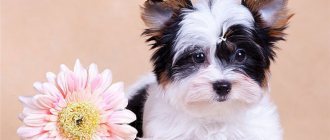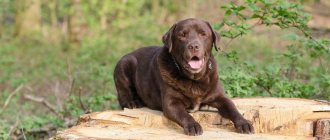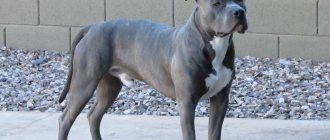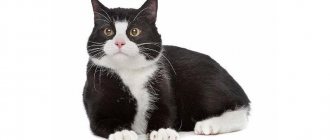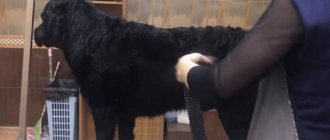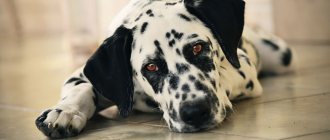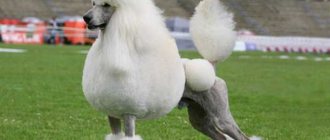Interest in dogs performing a variety of roles remains at a high level. Particularly popular are breeds endowed with hunting and guard instincts. The value of such dogs increases if they are used as rescuers, guide dogs, and companions.
The black Labrador meets all these criteria. It is believed that the first representatives of this breed appeared in eastern Canada on the island of Newfoundland. But other colors have also been established as a modern standard.
Breed standard and genetics
According to the standard, the color of a Labrador can be as follows:
- Black. Black dogs have the same pigmentation of the nose, lips and eyelids.
- Chocolate. This type has brown pigmentation.
- Pale yellow. The fawn Labrador has a light coat (ranging from almost white to red) and black lips, eyelids and nose.
In fact, it is impossible to tell what color the puppy will be based on the coloring of the parents. This breed is a real mystery for dog handlers, so in order to at least approximately determine the color of the puppy, experts carefully study its pedigree. And even with all this, the result may turn out to be completely opposite to what was expected.
Character does not depend on coat color
Having decided to purchase a puppy, the future owner may suddenly wonder: “Will the color of the coat affect its abilities and development in the future?” This is a misconception. We assure you that the color of a Labrador’s coat does not affect:
- natural temperament;
- innate character or acquired traits;
- health given by parents;
- learning ability;
- memory;
- bad habits acquired from improper upbringing.
Thanks to serious breeding work by specialists from different countries, the breed was constantly improved, while maintaining its basic qualities. First of all, Labradors remained hunting dogs that loved to swim and expressed unlimited trust in their owner. The main external characteristics that have been preserved are the special otter tail and short, hard hair with a fatty coating that repels water. But the colors of dogs have repeatedly undergone visible changes. Different tones appeared.
Black Labrador
It was this Labradorite, black as night, that attracted the attention of Europeans more than a hundred years ago. Black Labrador is the rule rather than the exception. The fact is that this color is dominant, so if the corresponding gene is present in the genotype, the dog can only be black. Such dogs are very beautiful and there is not a single light hair on their entire body. The only exception is a small white spot on the chest, which can sometimes be seen on representatives of this breed. The eyes of such dogs are usually brown, but the color of dark chocolate is considered ideal.
We recommend this article:
What is tasty and healthy to feed your Labrador at home?
Straight-haired (Flat-Coadet)
Flat retrievers are actively gaining popularity, trying to catch up with Labradors. The dogs were bred in Britain at the end of the 18th century, but the breed was finally formed in the mid-19th century.
Like their brothers, Flats are waterfowl hunters. At first, the animals worked together with the Spaniels, catching birds, but later they only began to bring shot prey.
The first individuals had wavy hair; at exhibitions the breed received the name “Wavy-haired”, but the wool did not have the required density and water-repellent properties. Therefore, other breeds were mixed into the blood to improve the protective properties of the cover.
Chocolate Labrador
There are fewer of these dogs, so a small purebred chocolate-colored puppy will cost much more. There are several acceptable shades for chocolate Labradors:
- light chocolate;
- hepatic;
- bitter chocolate.
Related article: How to care for a puppy and an adult Labrador
The coat must be a single color and the standard excludes the presence of any spots or even hairs of a different color (although a light patch on the chest is still allowed). Therefore, be very careful when choosing a chocolate-colored dog - there are many unscrupulous breeders, and they may well profit from your ignorance. The dog's eyes should be brown, although it is acceptable if there is a yellowish tint.
We recommend this article:
Weight of a puppy and an adult Labrador by month
Owner reviews
All owners unanimously mention the friendliness and calmness of Labradors, their tireless energy and extraordinary intelligence - they only need to repeat a command a couple of times, and they remember it forever. These dogs cannot stand loneliness, are sad, and love children very much.
Even training lessons for these dogs turn into a holiday, because their beloved owners are next to them.
Fawn Labrador
For quite a long time, beige representatives of this breed were considered a defect, and fawn color was included in the standard only in 1924. Now the situation has changed dramatically, and some breeders specialize in breeding Labradors exclusively of fawn color.
The following shades are allowed:
- golden;
- cream;
- almost red;
- liver (light);
- grey.
Note that the white Labrador is a type unknown to genetics. Fawn Labrador puppies can be very light in color, but they will never be white. The eye color of cream dogs is brown, and the pigmentation of the nose, lips and eyelids is very dark.
We recommend this article:
Pros and cons of keeping a Labrador in an apartment
Unusual colors
In addition to those described above, there are species with unusual colors. These include Dudley, spotted and silver Labradors. The main difference between Dudley and the standard is the pinkish tip of the nose and light pigmentation of the gums and eyelids. Golden dudleys are most common, but they also come in black and cream. The eyes of these animals may even be green, which is unacceptable for the standard.
Spotted dogs are also considered an unacceptable deviation from the standard, although they look quite cute. But the silver Labrador, which is not included in the breed standard, is quite popular at the moment. Although it will not be possible to participate in exhibitions with him, many people want to buy a dog of this particular color. And demand, as you know, creates supply, so silver dogs can be purchased at a very high price. Although you will not be able to participate in dog shows with a pet of non-standard colors, this does not mean that such a dog will not become a loyal friend and family member. In addition, by purchasing an animal of an unusual color, you will spend much less money.
Similar article: Weight of a puppy and an adult Labrador by month
Other types of retrievers
The breeds included in the group of retrievers differ in appearance and size, but they have one specialization - all retrievers were originally bred for gun hunting.
Nova Shatland duck (Toller)
The smallest representative of the group: height at withers up to 53 cm, weight up to 25 kg. Bred in the Canadian province of Nova Scotia for hunting waterfowl.
Tollers are fast, energetic, have excellent working qualities, but at the same time they can be stubborn and self-willed. While working, they are concentrated, attentive, and persistent.
Compact format. The medium-length, thick coat has a dense, waterproof undercoat. The color of the fiery fox is reddish-red.
Curly-Coated (Curly-Coated)
An Old English breed, known since the beginning of the 19th century. Even among retrievers, it stands out for its intelligence, courage and keen sense of smell. The main breed characteristic is curly dark brown or black wool, reminiscent of astrakhan fur.
Height up to 69 cm, weight up to 35 kg. The dogs are calm, independent, excellent watchdogs and hunters.
Flat-haired (Flat-Coadet)
The homeland of flats is the British Isles. Height at withers up to 61 cm, weight up to 36 kg. Good swimmers, used for hunting wading and waterfowl.
Flat-Coated Retrievers make excellent athletes. They often achieve success in agility and flyball. Active, cheerful dogs are always ready for long hikes, games, and work. Color black or chocolate.
Chesapeake Bay
Bred on the coast of the Chesapeake Bay in the USA. A powerful, beautiful, strong dog, exceptionally efficient and hardy. Height up to 66 cm, weight up to 34 kg. The coat is short and harsh. Camouflage color - shades of brown, withered grass, reeds.
Dogs are used to hunt waterfowl, marsh and land birds and as guards. Loyal to their owner, smart, cheerful.
Golden (Gold, Golden)
The Golden Retriever is confused with the fawn Golden Labrador. The dogs are similar not only in appearance, but also in type of temperament and purpose. Just like Labradors, goldens are used not only for hunting, but also as companion dogs. They are often hired to work at customs, used as rescuers, guide dogs, therapy dogs and caregivers.
They differ from Labradors in their long, wavy, silky coat. Height up to 61 cm. Color - all shades of golden and cream, except red and red.
NOTE!
All retrievers attract with their charm and originality. They are not characterized by aggression, but at the same time, they are endowed with courage and bravery. These dogs are infinitely devoted to their owner and his family. It is not for nothing that the Labrador and Golden Retriever are firmly in the lead in the ranking of the most popular breeds in the world.
What does color affect?
The color has absolutely no effect on anything. It may seem that black dogs are more stern, while white dogs are good-natured. However, appearances are deceiving. All dogs are very friendly and can easily become full members of the family. They are excellent hunters and swimmers, and are also easy to train. Therefore, choose a color based on personal preference. Regardless of what color the dog is, you will get an excellent companion.
We recommend this article:
What to look for and how to choose the right Labrador puppy
a brief description of
In 2003, the Labrador Retriever was officially recognized as the most popular dog in the world. Their path to triumph began on the island of Newfoundland, where “water dogs” covered with dense, waterproof black fur had long lived.
The dogs were brought to Great Britain, where their working qualities were immediately appreciated by gamekeepers and foresters. It turned out that they have an innate ability to hunt with guns. In 1903, the breed, called the Labrador Retriever, was officially recognized by the British Kennel Club.
However, not only success in hunting, beauty and impressive size served as the basis for the rapid growth of the population and popularity of Labrador retrievers throughout the world. The main reason lies in their character.
Like no other breed, Labradors are focused on the owner and his environment.
They have the following qualities :
- have a strong mobile type of nervous system, are able to withstand prolonged stress, are easy to train, and obedient;
- not aggressive, not shy, good-natured, gets along well with children and pets;
- intelligent, smart, not intrusive;
- hardy, patient, love to work;
- easily adapts to new conditions and situations.
NOTE!
Labradors are the best companion dogs. They are more often than other breeds used as guide dogs, rescue dogs, search dogs, and assistants for people with disabilities.
Labradors have several other advantages:
- their fur does not have a specific “dog” smell and does not cause allergic reactions;
- they have innate immunity to some infectious diseases;
- they retained all the skills of a hunting dog.
Which color to choose
As stated earlier, this is a matter of personal preference, but there are several factors you can consider when choosing. Remember that dogs love “mud baths.” They love to roll around in the dirt, so most of the time your pet will be spotted instead of light colored. For this reason, some people prefer to have dogs with black fur. However, you will have to wash your pet in any case - no matter how clearly it is visible that he is smeared in dirt.
Also keep in mind that individuals with brown fur can fade in the sun, and due to the activity of the animal, it will not be possible to keep it in the shade. Therefore, in the hot season, the pet’s color may be uneven. Of course, with the onset of cold weather, the color will return to normal, so there is no need to worry about this.
If you want your pet to look menacing and impressive, choose a black dog.
They have a rather dangerous appearance, so you are unlikely to encounter bullies if such a defender is nearby. There is also an opinion that dogs with dark hair are much more difficult to photograph than light ones. So if you are going to show off your pet to the whole world, choose more photogenic, light-colored dogs.
Similar article: What types of Labrador mixes exist in nature?
In general, all these factors are insignificant. Whatever color the dog is, it will make a great friend. You just need to give her your love and care, and she will definitely reciprocate.
We recommend this article:
How to choose a nickname for a Labrador boy and girl
What does the price consist of and what does it depend on?
The main component of the price of a Labradorite is health. Both parents of the dog must have appropriate testing done to ensure there are no genetic abnormalities. Labradors often have genetic abnormalities such as elbow and hip dysplasia. There must also be a complete examination of the animal. How much a Labrador dog costs depends on many components listed below.
Pedigree and title
One of the main components of the price is the dog's pedigree. Without a pedigree, an animal is considered a mongrel. Having a pedigree confirmed by the International Canine Federation (its branches are in every country of the former USSR).
A very important factor is the titles of the parents. If a dog participates in various canine exhibitions and becomes a winner of prestigious awards, then this is considered confirmation of its good physical characteristics. Beautiful children are born from beautiful parents. And yet, the title and awards of the parents are not absolute indicators of health, but they do well demonstrate compliance with breed standards.
Appearance of the dog
If you follow one of the classifications, then all adult dogs are divided into 3 classes:
- pet class (pet);
- breeding class (dog for breeding);
- show class (dog for exhibitions and events).
There is also breeding (dogs that do not meet breed standards). Puppies from such a marriage cost approximately the same as show-class puppies. This is due to the fact that caring for dogs with defects is quite expensive. They are rarely sold, as the reputation of the breeder decreases.
Feed
The influence of dog food does occur. A puppy or adult that was raised on natural food will cost more than an animal that was fed dry food. This can sometimes be difficult to verify.
Age and gender
Among most dog breeds, males are more expensive than females. The demand for males very often exceeds the demand for females. This is often due to the fear of inexperienced dog breeders that when purchasing bitches they will be in heat, which means they will have to be bred or sterilized. Male dogs are often distinguished by greater speed and endurance.
The sooner a puppy finds its owner, the less the owner will invest in it. It's profitable. However, the younger the puppy is, the more difficult it is to understand what he will be when he grows up. It is quite natural to assume that the younger the puppy, the lower its cost.
There is such a practice. A slightly older puppy is given away for a small amount, almost for nothing - the main thing is that they take it. Many inexperienced breeders and even some dog sellers worry that if the puppy is not purchased, it will remain for a very long time.
Also, those who buy a dog for the first time, often as a pet, like to buy a very small puppy, even a newborn, in order to consider it exclusively theirs, independently raised and educated. Experienced dog breeders take a slightly older puppy, since its approximate external characteristics can already be seen. In this case, much depends on the experience and professional competence of both the seller and the breeder.
Breeder
Very often this is a person who does not have a canine, zoological or veterinary education. Such a person is getting puppies for the first or second time. A male dog should be chosen for reasonable reasons and not for financial gain. The breeder is obliged to conduct and check the pedigree of the dog.
Mating
The price of a puppy greatly depends on complications during mating, pregnancy and childbirth. It's one thing when everything happens naturally. Another is when you have to turn to breeding services or a veterinarian, especially during childbirth. They are very expensive, as are medicines. Another factor is the number of puppies in the litter. The fewer there are, the more expensive each of them is.
Nursery
The cost of a dog is influenced by the demand, condition, prestige and popularity of the kennel. A nursery, as a rule, gains its fame when its inhabitants become laureates of various awards, win sports competitions, and canine exhibitions. All this is preceded by various stages: the correct selection of pairs, feeding, education, etc. The kennel can in many ways serve as an indicator of the quality of representatives of the dog breed, in particular the Labrador.

